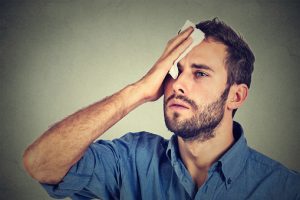
Under normal conditions, the body is using sweating as a means of cooling down when temperature rises. Sweating occurs when the blood vessels on the skin dilate, allowing for more blood flow to come to the surface. This way, heat from the blood is lost through the skin. The sweat glands are then stimulated to release the sweat, which is evaporated as a normal part of cooling down.
In cold sweats, the sweat glands are abnormally stimulated despite the presence of heat. This abnormal activation of the sympathetic nervous system causes perspiration, which is often described as cold or clammy.
Here we will outline the common causes of cold sweats along with the associated treatment.
Causes of cold sweats
Pain: A person who is suffering from intense pain as a result of fractures or even migraines may experience a response in a form of cold sweats.Injury pain may also lead to shock-like symptoms causing sweat, where your body feels that it is unable to supply enough oxygen to various organs. Taking over-the-counter pain medications, such as NSAIDs (nonsteroidal anti-inflammatory drugs) can help relieve intense pain and put a stop to cold sweats in the process. However, it is recommended to take NSAIDs as directed and to follow the advice outlined by your doctor about using them for your particular case.
Stress, anxiety, or fear: High stress, anxiety, or fear can trigger a fight-or-flight response, which can abnormally trigger the sweat glands to cause cold sweats.Having chronic cases of anxiety can put undue stress on the body and mind, disrupting daily routines or even leading to long-term health effects. It is recommended to speak to a doctor about your anxiety symptoms if you feel that they are disrupting aspects of your personal and work life.
Lack of oxygen (hypoxia): Lack of oxygen in the blood could cause shortness of breath and trigger the brain to seek out oxygen, thus setting off a stress response causing cold sweats.
Low blood sugar (hypoglycemia): When sugar levels drop, symptoms like dizziness, trembling, blurred vision, and cold sweats can occur.
Low blood pressure (hypotension): Similar to low blood sugar, when blood pressure drops below 90/60, one can experience dizziness, clammy skin, and cold sweats.
Shock: Shock can come in many different forms, including anaphylactic shock (severe allergic reaction), cardiogenic shock (heart failure and other heart conditions), hypovolemic shock (blood loss and low blood volume), septic shock (blood poisoning), and neurogenic shock (nervous system disruption or damage). It can cause your body to decrease the amount of oxygenated blood sent to various organs and body parts. If a state of shock is sustained for extended periods of time, organ failure or even death may result. Cold sweats are a common symptom of many types of shock.
Menopause: Although hot flashes are most common in menopause, cold sweats can also occur as a result of hormone level changes.
Migraines: Migraines can be triggered by stress or environmental factors and, as mentioned earlier, because of the associated intense pain they can also trigger cold sweats.
Heart attack: This is the most severe condition that has cold sweats as a symptom. Look for accompanying symptoms such as chest and arm pain to determine if you are having a heart attack.
Hyperhidrosis: This is a medical term for excessive sweating and may only affect some areas of the body, or the body as a whole. This condition is believed to be a result of overactive sympathetic nervous system, which is responsible for stimulating the sweat glands. This is not a serious condition, but it can be quite embarrassing.
Infection: Bacteria and viruses attacking the body will cause your immune system to go on high alert. This will activate a number of immune-related processes in an attempt to irradiate the infection. One of these processes is to raise body temperature, which will cause a cold sweat to form as the fever begins to go back down again.
Other health conditions: Other health conditions that can trigger cold sweats include motion sickness, severe pain, vasovagal reaction, psychological stress, recurrent vomiting, infections like HIV and tuberculosis, and fever.
Cold sweats can be a primary symptom or they can occur alongside other symptoms. Recognizing these other accompanying symptoms can help you narrow in on the possible underlying cause of your cold sweats.
Symptoms of cold sweats include aches and pains, anxiety and stress, chills, dizziness, nausea and vomiting, pale skin, and weakness.
Treatment options for cold sweats
What kind of treatment you require depends on the cause of your cold sweats. Here are some general treatment methods to treat your cold sweats at home.
- Manage stress and partake in relaxation techniques
- Make changes to your sleeping environment – wear loose-fitting clothes, remove lights, or lower the temperature
- Avoid consuming food prior to bed as it can trigger nighttime cold sweats. Also, eat foods that keep your blood sugar leveled, so it does not crash
- Keep yourself busy during cold sweat episodes as a means to further reduce stress
- If cold sweats worsen or are accompanied by other more serious symptoms, seek out medical attention
- Don’t smoke
- Exercise regularly
- Stay hydrated throughout the day
By following these tips, you can experience greater relief from your cold sweats. As mentioned, if symptoms worsen or new ones appear, speak to your doctor as there could be a more serious underlying cause for your cold sweats.
More serious symptoms that should prompt you to seek medical attention include changes in alertness or consciousness, change in mental status or behavior, chest pains, shortness of breath, grey or bluish discoloration of lips and nails, higher fever, palpitations, seizure, severe pain, throat tightness, uncontrolled bleeding, as well as vomiting blood or passing bloody stools.